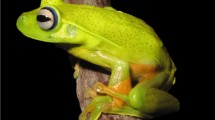Summary.
Some plant volatiles are produced in response to herbivory of several insect species, including heliothine larvae. In the present study of female heliothine moths, four co-located receptor neurone types were identified, of which three types responded strongest to the inducible compounds E-β-ocimene, E,E-α-farnesene and E,E-TMTT, respectively. The fourth type responded strongest to geraniol, which is a common floral volatile. The narrow tuning of each receptor neurone type was demonstrated by responses to a few structurally-related monoterpenes, sesquiterpenes, homo-terpenes and monoterpene alcohols, respectively, out of hundreds of plant constituents tested. The four neurone types showed the same relation of spike amplitudes and ranking of effective compounds in the three heliothine species; the polyphagous Heliothis virescens and Helicoverpa armigera and the oligophagous Helicoverpa assulta. The results indicate the presence of functionally similar types of plant odour-receptor neurones in the three related species, and suggest conservation or reappearance of functionally similar olfactory receptors in related species, independent of the evolution of polyphagy and oligophagy.
Similar content being viewed by others
Author information
Authors and Affiliations
Corresponding author
Rights and permissions
About this article
Cite this article
Stranden, M., Røstelien, T., Liblikas, I. et al. Receptor neurones in three heliothine moths responding to floral nd inducible plant volatiles. Chemoecology 13, 143–154 (2003). https://doi.org/10.1007/s00049-003-0242-4
Received:
Accepted:
Issue Date:
DOI: https://doi.org/10.1007/s00049-003-0242-4




